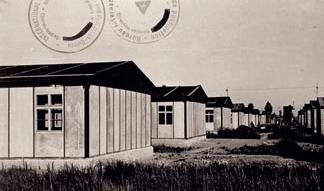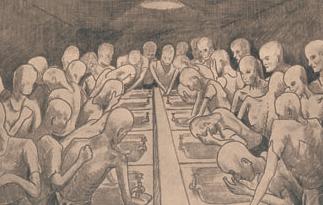Clothing, Housing, Hygiene
Clothing
Initially, all prisoners wore the blue and white striped prisoners’ uniforms made from inferior fabrics such as spun rayon. Their wooden-soled shoes were primitive and were mostly made from left over fabric or leather. The prisoner’s number and the colour-coded triangles identifying the different groups of prisoners were sewn to the jackets and the trousers. From 1943, more and more civilian clothes, some of which came from the extermination camps, were issued to prisoners.Striped pieces of cloth or crosses and stripes in bright oil paints had to be applied to these pieces of clothing so that they would stand out in the event of an escape attempt. Clothes and shoes often did not fit properly and offered minimal protection against the elements. Some prisoners illegally wore old paper cement sacks underneath their clothes or tried to acquire fabric on the camp’s black market.
Housing

SS photograph of prisoners’ quarters in 1940/41. At this time, the huts still lacked the connecting washrooms andlatrines. Prior to the construction of the sewer system in the first half of 1941, prisoners could only obtain water fromhand pumps. Photograph from the Heinz Masset photo album, acquired in 1981.
During the first few years, the prisoners had to sleep on the crowded floors of the two-block wooden huts. In 1941, the huts were fitted with three-tier bunk beds, lockers, tables, and benches. Over 300 prisoners, and sometimes even more than 600 prisoners, were usually crammed into each 50 metre by 8 metreblock. The two stone buildings erected in 1943/44 contained four blocks each, in which 500 to 700 prisoners were housed, while the “convalescence blocks” held even more prisoners. From 1944, two and sometimes even three prisoners had to share one bunk. This overcrowding made restful sleep impossible. The quarters reeked of sweat and faeces because of the insufficient sanitary facilities and because many prisoners suffered from diarrhoea. Prisoners had no privacy what so ever, and the best bunks usually went to the strongest prisoners.
Hygiene
In 1940/41, there were only manual pumps in the blocks, and the sanitary facilities remained insufficient even after the construction of the sewer system in 1941.In the morning, hundreds of prisoners had to crowd around the 15 to 20 taps in the washrooms. It was not until the typhus epidemic of 1941/42 that prisoners began to be taken in groups to the newly constructed showers. Initially this occurred on a weekly basis, but the frequency decreased continually, and by 1944/45, prisoners were only taken to the showers on special occasions (after their arrival in the camp or before their transfer to another camp, for example). There were hardly any towels or soap. In the beginning, prisoners received a new set of underwear every two weeks, but later on this happened even more rarely. From 1942, the poison gas Zyklon B was used in the huts to exterminate vermin, but fleas and other pests were still abundant.
Drawing by Hans Peter Sørensen. This is the sixth drawing from his Neuengamme portfolio published in 1948. Printbased on a pencil drawing. Hans Peter Sørensen added the following comments: “A small room inside the block was used as a washroom. It was equipped with around 10 sinks which had to be used by 500 to 600 prisoners in the space of one hour every morning. Of course, many prisoners were therefore unable to wash at all, and this created anideal breeding ground for lice.”
